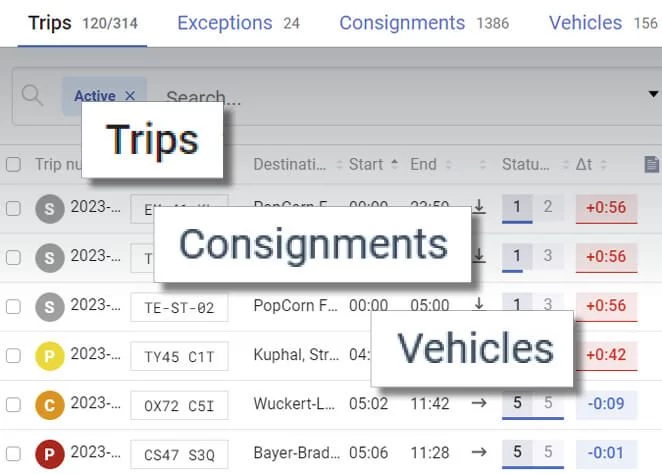In today’s dynamic logistics landscape, the demand for flexible, efficient, and sustainable distribution chains is driving innovative advancements in transport execution and delivery management. Entire supply chains, comprising a series of trips, can now be monitored and optimized in real-time—extending capabilities far beyond the boundaries of a single trip. This level of granular insight, down to the order level, empowers all stakeholders—planners, shippers, receivers, carriers, and drivers alike—with relevant, actionable status updates and the tools needed to make proactive adjustments.
Many parties are involved in fulfilling transport orders. Suppose you buy a door from a hardware store. Then the DIY store engages a carrier to collect that door from the door manufacturer, another carrier to transport it to an assembly warehouse and a third carrier to deliver the order to you as the end customer. So for one simple order, at least seven parties are involved. The better they work together, the chances of the order being delivered on time and complete increase exponentially.
Smooth collaboration between all supply chain parties will guarantee a successful delivery. And more likely that assets are used efficiently and no unnecessary CO2 emissions or (social) nuisance is caused.
The transport sector is currently under a lot of pressure, with a scarcity of drivers, planners and logistics staff. But shippers have higher demands than ever for timeliness and reliable deliveries. As a transporter, you cannot tell a retail customer: ‘Unfortunately we were not able to replenish your shops today.’ High demands are also placed on the way transport companies communicate about and manage their trips. Shipping and receiving addresses must be kept constantly informed about the arriving time of a truck or delivery. As soon as an upfront agreed time is not going to be met, planners or transport managers must intervene immediately. Perhaps a load can be transferred to another vehicle? Or maybe a charter can be called in? Or is the recipient willing to accept a different time slot for receipt?
Just as there are countless reasons why an order goes off schedule. For instance, a sick driver, traffic jams or a vehicle breakdown. There are also many ways to solve these.
Immediate adjustments of an ongoing transport operation hinges on the availability of real-time data. Think of GPS locations of trucks, current traffic conditions, expected arrival times and status of transport orders. It’s necessary to provide all stakeholders the right perspective on that data so that they can act on it optimally.
Back to our example: The shipping department of the door factory, does not need to know about a road closure. They just want to see the expected arrival time of the truck so they can make sure the door is ready on time. The planner of the transport company that takes your door from the consolidation hub to the delivery address, does not need to see when the door can be collected from the manufacturer. But he does want to know when you will be home to receive the delivery. The logistics manager of the hardware store does not need to know what subcontractors of his carriers are all transporting. But does want to see what the delivery reliability is towards his customers. In short, when carrying out a transport operation, each stakeholder has its own information i.e. data needs. A collaboration platform must provide perspectives that match everyone’s specific role.
Dynamic transport operations depend on being able to monitor your transport data-driven and make adjustments when needed. It allows stakeholders to monitor the operation at the right level, e.g. at trip, shipment or asset level. At trip level is especially applicable in shop distribution or home delivery processes of groceries. These are situations where shippers (supermarkets) have such large volumes that they can have carriers drive fixed trips. These trips are usually assigned to only one driver or means of transport, making status monitoring relatively easy.
It becomes more complex when transport orders are distributed among several carriers and if there are collection, network and distribution trips. Such as in the case of the previously mentioned hardware store. Then you need order-level insights. A perspective that allows you a holistic view ‘across means of transport’ and monitor the real-time status of transport orders. Regardless of how they are distributed among drivers, trucks or other transport companies, or just bundled into groupage trips.
The advantage of looking at transport at shipment level is that you can manage timeliness and load factor within a network of carriers. Trip supervisors receive notifications about delays at the earliest possible stage. They can see at a glance what consequences these delays have for the rest of the order processing. In the past, they had to wait for a driver to contact them and kept running behind the facts during the day. But with a solution like Simacan, they are immediately informed. Thus immediately start working on solutions to ensure that incidents do not have a negative impact for customers. Added bonus: the Simacan platform helps with finding solutions. For example, the trip planner can start filtering on vehicles currently operating in the region. And see which partner carrier might still have time and space to take over a load. And they can contact drivers directly by using the chat function.
Unlocking and making real-time transport data transparent across the whole supply chain provides the perfect basis for the digital waybill or consignment note. Companies that want to work with eCMR’s need to provide various data to do so: origin of goods, destination of goods, name of carrier, name of customer, etc. This data is collected in a platform such as Simacan! Once a connection is made, communication with an eCMR provider will be fully automatic. But apart from lowering the threshold for paperless processes, there is another advantage: linking consignment notes to a platform also ensures higher process quality.
Suppose a driver forgets to have a receiving party digitally sign for receipt – which is necessary for eCMR – Simacan will signal this immediately upon leaving the dock. A notification will then be automatically sent immediately to the relevant people.
In short… with the three interrelated views offered by Simacan, logistics companies have the tools they need to maintain their transport performance under the most challenging and changing conditions. The trip list provides an overview of all trips, easily filtered for exceptions. The Shipment Status provides insight into shipments seen across the entire transport chain. And the Transport Asset Status shows what individual vehicles are doing. With one click it is easy to switch between these 3 views, to make quick and effective adjustments.




